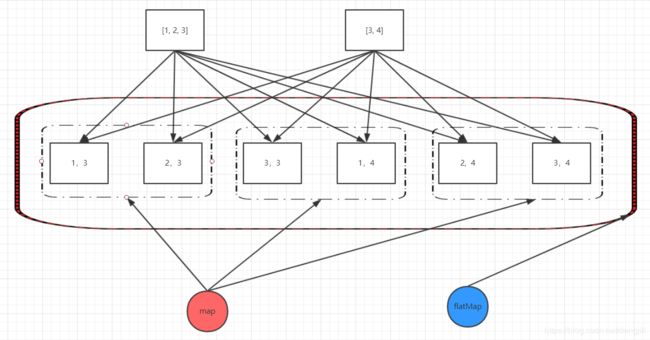java 8 Stream中flatMap方法
在java 8 Stream中,flatMap方法是一个维度升降的方法
举例说明
给 定 单 词 列 表[“Hello”,“World”] ,要返回列表 [“H”,“e”,“l”, “o”,“W”,“r”,“d”] 。
使用map方法,代码如下:
public class StreamStr {
public static void main(String[] args) {
List<String> list = Arrays.asList("tom", "jame", "jerry", "hello");
Stream<String> stream = list.stream();
Stream<String[]> streamString = stream.map(s->s.split(""));
Stream<Stream<String>> map = streamString.map(Arrays::stream);
// List> collect = map.collect(Collectors.toList());
// System.out.println(collect);
map.forEach(x->{
x.forEach(s->{
System.out.println(s);
});
});
}
}
测试结果:
t
o
m
j
a
m
e
j
e
r
r
y
h
e
l
l
o
转变类型为:String -> String[]-> Stream,当前维度从一维变成二维,map本身不能降为,执行如下

引入flatMap方法
具体代码变化如下:
public class StreamStr {
public static void main(String[] args) {
List<String> list = Arrays.asList("tom", "jame", "jerry", "hello");
Stream<String> stream = list.stream();
Stream<String[]> streamString = stream.map(s->s.split(""));
Stream<String> map = streamString.flatMap(Arrays::stream);
map.forEach(x->{
System.out.println(x);
});
}
}
测试结果:
t
o
m
j
a
m
e
j
e
r
r
y
h
e
l
l
o
flatMap升维
给定两个数字列表,如何返回所有的数对呢?例如,给定列表[1, 2, 3]和列表[3, 4],应该返回[(1, 3), (1, 4), (2, 3), (2, 4), (3, 3), (3, 4)]。
public class StreamInt {
public static void main(String[] args) {
List<Integer> numbers1 = Arrays.asList(1, 2, 3);
List<Integer> numbers2 = Arrays.asList(3, 4);
// flatMap升维度
List<int[]> pairs = numbers1.stream().flatMap(x -> numbers2.stream().map(y -> new int[] { x, y }))
.collect(Collectors.toList());
for (int[] pair : pairs) {
System.out.println(Arrays.toString(pair));
}
}
}
测试结果:
[1, 3]
[1, 4]
[2, 3]
[2, 4]
[3, 3]
[3, 4]
总结:flatMap将map结果归类,从而达到升降维目的

